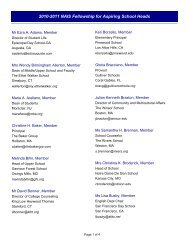History of NAIS from the Nineties to the New Millennium
History of NAIS from the Nineties to the New Millennium
History of NAIS from the Nineties to the New Millennium
Create successful ePaper yourself
Turn your PDF publications into a flip-book with our unique Google optimized e-Paper software.
Recognition <strong>of</strong> <strong>NAIS</strong>’s place in <strong>the</strong> pan<strong>the</strong>on <strong>of</strong> American elementary and secondary<br />
education is illustrated by responses <strong>to</strong> something I said in 1996 about <strong>the</strong> role <strong>of</strong><br />
independent school heads as <strong>the</strong> leaders <strong>of</strong> educational reform and improvement in <strong>the</strong>ir<br />
communities. “Heads <strong>of</strong> independent schools are <strong>the</strong> logical candidates <strong>to</strong> lead. The<br />
college presidents are <strong>to</strong>o busy talking about football and raising money. The public<br />
school superintendents and principals are beleaguered. Our school heads can be model<br />
learners and leaders, <strong>the</strong> catalysts, <strong>the</strong> facilita<strong>to</strong>rs who bring people <strong>to</strong>ge<strong>the</strong>r <strong>from</strong> across<br />
<strong>the</strong> educational spectrum <strong>to</strong> focus on real improvements in opportunity for all our<br />
country’s children.”<br />
Some reactions were, “Who <strong>the</strong> hell do you think you are?” “You guys in <strong>the</strong> rich schools<br />
don’t really understand or care about <strong>the</strong> public.” But o<strong>the</strong>rs said, “You know, what you<br />
say is true. You’re right.” “<strong>NAIS</strong> is already leading with <strong>the</strong> influence <strong>of</strong> your Principles<br />
<strong>of</strong> Good Practice on America’s public and private schools; you might as well take <strong>the</strong><br />
reins <strong>of</strong> leadership, <strong>to</strong>o.” And with that my colleague association heads – leaders <strong>of</strong> more<br />
than 25 national education organizations – said that <strong>NAIS</strong> had <strong>the</strong> independence, among<br />
o<strong>the</strong>r qualities, <strong>to</strong> lead. I was honored <strong>to</strong> accept <strong>the</strong> presidency <strong>of</strong> <strong>the</strong> Education Leaders<br />
Consortium representing all <strong>the</strong> prominent, influential national associations. Again, it<br />
was that move <strong>to</strong> <strong>the</strong> nation’s capital that set <strong>the</strong> stage….<br />
THE BATTLE FOR INDEPENDENCE<br />
Where <strong>to</strong> begin on <strong>the</strong> struggle with U.S. <strong>New</strong>s and World Report about ranking schools?<br />
If <strong>the</strong> magazine ever tells <strong>the</strong>ir version <strong>of</strong> <strong>the</strong> effort <strong>to</strong> rank and rate public, parochial, and<br />
independent schools, I’m certain it will have no similarity <strong>to</strong> what <strong>NAIS</strong> has said. To<br />
create ano<strong>the</strong>r cash cow similar <strong>to</strong> <strong>the</strong> lucrative ranking <strong>of</strong> colleges and universities U.S.<br />
<strong>New</strong>s approached <strong>NAIS</strong> in 1996 <strong>to</strong> gain our cooperation. Polite conversation led quickly<br />
<strong>to</strong> threats and intimidation, and <strong>the</strong> magazine threw its determined efforts at <strong>NAIS</strong>, <strong>the</strong><br />
National Catholic Educational Association, and <strong>the</strong> National Association <strong>of</strong> Secondary<br />
School Principals. We association execs and <strong>the</strong> vast majority <strong>of</strong> independent school<br />
leaders held firm against <strong>the</strong> magazine. Included here is our statement on ranking<br />
schools <strong>from</strong> <strong>the</strong> March 1997 Executive Summary, because it says volumes about<br />
independence and choice, about <strong>the</strong> importance <strong>of</strong> each school and <strong>the</strong> dignity <strong>of</strong> <strong>the</strong><br />
individual child. We said:<br />
With this, as with all questions related <strong>to</strong> elementary and secondary<br />
education, we must keep our focus on children’s best interests. <strong>NAIS</strong> is<br />
and always has been opposed <strong>to</strong> ranking <strong>of</strong> schools. The “best” school –<br />
public, parochial, or independent – is <strong>the</strong> one that uniquely meets <strong>the</strong><br />
needs <strong>of</strong> each particular child.<br />
In <strong>the</strong> independent school sec<strong>to</strong>r, each institution, in its mission statement,<br />
defines its own objectives: <strong>the</strong> kind <strong>of</strong> program and campus culture <strong>the</strong><br />
school provides, and <strong>of</strong>ten, <strong>the</strong> qualities that will help a student <strong>to</strong> succeed<br />
<strong>the</strong>re. The schools were not created <strong>from</strong> one mold. They have different<br />
missions, <strong>of</strong>fer different grade ranges, curricular emphases, pedagogical




